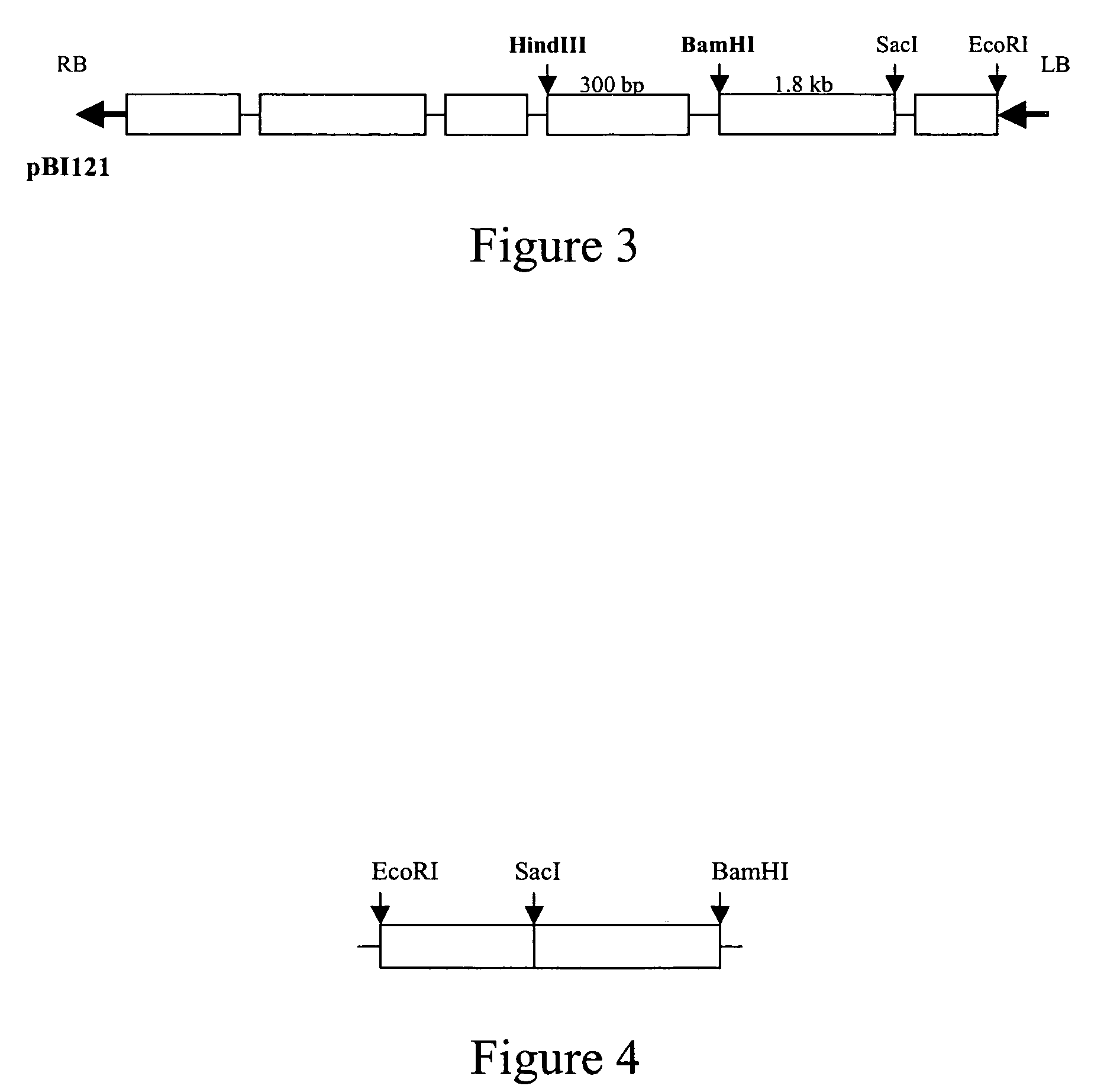Regulation of gene expression in plant cells
a technology of plant cells and gene expression, applied in plant cells, biochemistry apparatus and processes, fermentation, etc., can solve the problem of significantly reducing efficiency by removing the terminator region
- Summary
- Abstract
- Description
- Claims
- Application Information
AI Technical Summary
Benefits of technology
Problems solved by technology
Method used
Image
Examples
example 1
Vector Construction
pBI121 Anti-GUS:ΔTerm
[0067] The GUS gene of pBI121 was reoriented to the anti-sense orientation as follows. The binary vector pBI121 was digested with BamHI and EcoRI to excise the GUS-Nos-terminator fragment. The parent vector was purified by gel purification. The full-length GUS gene was PCR amplified using primers identified by SEQ ID NO:8 and SEQ ID NO:9 for insertion into the parent vector in the anti-sense orientation. Primers included the restriction sites BamHI and EcoRI to facilitate cloning. This anti-sense GUS fragment was ligated into the BamHI / EcoRI digested parent vector to yield the pBI121:Anti-GUS:ΔTerm construct (SEQ ID NO:1).
TABLE 1BI121: Anti-GUS: ΔTerm (SEQ ID NO: 1)Italicized sequences are the right and leftborder repeats. Underlined sequence is the 35Spromoter and bolded sequence is the GUS anti-sense sequence.gtttacccgccaatatatcctgtcaaacactgatagtttaaactgaaggcgggaaacgacaatctgatcatgagcggagaattaagggagtcacgttatgacccccgccgatgacgcgggacaagccgt...
example 2
Transformation
[0071]Arabidopsis transgenic plants were produced by the method of dipping flowering plants into an Agrobacterium culture, based on the method of Andrew Bent in, Clough S J and Bent A F, 1998. Floral dipping: a simplified method for Agrobacterium-mediated transformation of Arabidopsis thaliana. Wild type plants were grown under standard conditions with a 16 hour, 8 hour light to dark day cycle, until the plant has both developing flowers and open flowers. The plant was inverted for 2 minutes into a solution of Agrobacterium culture carrying the appropriate gene construct. Plants were then left horizontal in a tray and kept covered for two days to maintain humidity and then righted and bagged to continue growth and seed development. Mature seed was bulk harvested.
[0072] T1 plants were germinated and grown on MS plates containing kanamycin (50 μg / ml), and kanamycin resistant T1 seedlings were selected and transferred to soil for further growth. Alternative selective ma...
example 3
GUS Assays
[0075] Leaf tissue was harvested and incubated with GUS staining solution (50 mM NaPO4, pH 7.0, 0.1% Triton X-100, 1 mM EDTA, 2 mM DTT, 0.5 mg / mL X-GlcA) and left to incubate overnight at 37° C. The staining solution was replaced with fixation buffer (10% formaldehyde, 50% ethanol) and incubated for 30 minutes at room temperature. The fixation buffer was replaced with 80% ethanol and incubated for 1 hour at room temperature. The 80% ethanol was replaced with 100% ethanol and incubated for 1 hour at room temperature. The tissue was assessed for blue staining, indicating GUS activity.
PUM
| Property | Measurement | Unit |
|---|---|---|
| speeds | aaaaa | aaaaa |
| length | aaaaa | aaaaa |
| period of time | aaaaa | aaaaa |
Abstract
Description
Claims
Application Information
 Login to View More
Login to View More - R&D
- Intellectual Property
- Life Sciences
- Materials
- Tech Scout
- Unparalleled Data Quality
- Higher Quality Content
- 60% Fewer Hallucinations
Browse by: Latest US Patents, China's latest patents, Technical Efficacy Thesaurus, Application Domain, Technology Topic, Popular Technical Reports.
© 2025 PatSnap. All rights reserved.Legal|Privacy policy|Modern Slavery Act Transparency Statement|Sitemap|About US| Contact US: help@patsnap.com



